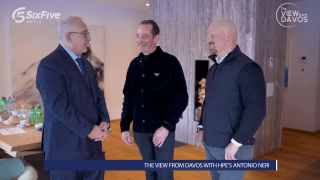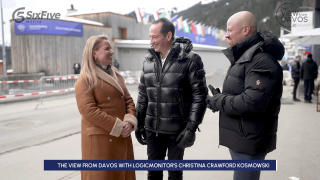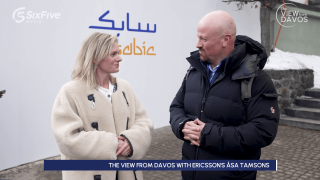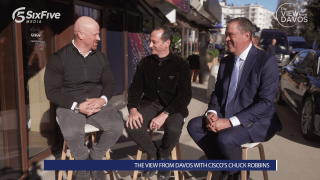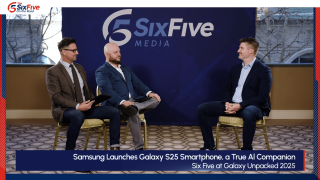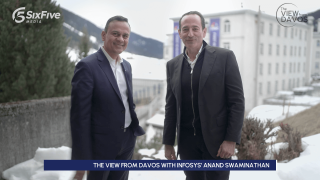On this episode of The Six Five – CXO, hosts Daniel Newman and Patrick Moorhead welcome Sachin Katti, SVP and GM of the Network and Edge Group at Intel, Martin Lund, SVP of Telco, Ops and Private 5G at Microsoft, and Tareq Amin, CEO and CTO of Rakuten Mobile/Rakuten Symphony, Inc.
Their discussion covers:
- Focusing network upgrades toward performance, energy efficiency, and flexibility of choice
- Catalyzing virtualization with their ecosystem partners
- Streamlining network upgrades, while driving down platform complexity and cost
- The factors that contribute to the complexity of service delivery
- How Intel is helping operators navigate their cloud-native journeys, both modernizing and monetizing their networks
It’s a great conversation, and one you won’t want to miss.
Be sure to subscribe to The Six Five Webcast so you never miss an episode.
You can watch the full video here:
You can listen to the conversation here:
Disclaimer: The Six Five CXO is for information and entertainment purposes only. Over the course of this webcast, we may talk about companies that are publicly traded, and we may even reference that fact and their equity share price, but please do not take anything that we say as a recommendation about what you should do with your investment dollars. We are not investment advisors, and we do not ask that you treat us as such.
Transcript:
Patrick Moorhead: Hi, this is Pat Moorhead and The Six Five is on the road in Barcelona, Spain. We are here at the Intel booth and this place is rocking. You can probably hear some of the excitement and the noise. I have to tell you though, Daniel, doesn’t it seem like MWC 2023 is bigger than ’22?
Daniel Newman: I think the hangover of the pandemic is over. The energy is really good. Like I said, from the minute we hit the show floor today, there was a lot of energy and it was before 8:00 AM, which in Spain is really, really early. I think it was night for some people actually as I was heading out. But no, it’s great to be back. MWC is one of my favorite shows every year and it’s good to be here in Barcelona.
Patrick Moorhead: Yeah, we are talking networking 24 x 7, whether it’s for the carriers, whether it’s for the enterprise. But gentlemen, thanks for coming on the show. I really appreciate that.
Sachin Katti: Thank you. Glad to be here.
Patrick Moorhead: Yeah, thanks for letting use the Intel booth as a backdrop here. But first of all, Sachin, let’s talk about what you do for Intel. New role. I mean Stanford, come on, what’s going on here?
Sachin Katti: Yes, lots of backdrop there. So I just stepped into the role to run the network and edge business at Intel. So I’m the new SPP and GM for NEX, as we call it at Intel. And the backstory here is I’m also a professor at Stanford. So I left Stanford to come take this role at Intel. So leaving the cushy gigs of academia and getting into the rough and tumble of business here.
Patrick Moorhead: Oh I thought you were going to tell us you’re running two jobs at the same time.
Sachin Katti: I wish I could. But this is a full-time gig. It’s actually a 24/7 gig, so really no time to do anything else. And I’m super excited to be here because I don’t really look at it as a different job. My research at Stanford was on how do I make the network software defined? And I look at this as an opportunity to actually make that happen in the real world and transform the industry in that direction.
Daniel Newman: That’s great. Yeah, so we’re going to talk a lot with you and I’m going to come back to you in just a second because I want to hear more about NEX, as you like to call the group. But I also just want to say Tareq, thanks for joining us, I have Rakuten here. And then of course Martin, thanks for having Microsoft and Azure here to represent, operator talking cloud provider talking with Intel. I think it’s going to be great to tie this all together. But Sachin, I do want to really start with what your focus is. Because as you said, you left… I mean making the joke aside of leaving cushy academia, you left. You must have seen something in the vision and said, “This is absolutely something I can get behind. It’s something I want to put some years into.”
Sachin Katti: Yeah, great question. So our mission here is how do we make the world’s infrastructure software defined? And I use the word infrastructure very broadly, whether it’s a network, an enterprise network, whether it’s a telco network or it’s even the physical infrastructure that we all use in our day-to-day life. You go to a fast food chain, you go to a retail store, you go to a factory floor. We want to make all of this infrastructure move from fixed function appliances to software-defined infrastructure on general purpose platforms. And that’s been my mission at Stanford. I think this is a great opportunity to make that happen in the real world and have impact. So that is actually the thesis behind forming NEX. So this is the network and edge group at Intel. And if you look at that phrasing, it’s both networking and edge computing being brought together.
So these are two separate businesses at Intel before. We had a very thriving networking business and we had a very thriving IoT business as it was called at that time. And our vision is that the world’s infrastructure is converging. So the same platforms that you used to run on network will also be the same platforms that you’ll use to run IoT and edge computing workloads. And so Intel I think is ahead of the world in that vision, and we brought the business together intentionally so that we can deliver these general purpose platforms to make that software defined transformation happen.
Patrick Moorhead: So big shifts in technology and markets. You have to have somewhat of a clean slate. And a challenge if you’re a carrier or a carrier technology provider is you can’t just stop doing what you were doing and then start doing something new. In fact, wasn’t there there eight different architectures in the market, let’s say, seven or eight years ago?
Sachin Katti: Yeah. I think I still vividly remember what the world was like a decade ago. The core was not virtualized and Intel started investing in how do we make the 4G core at that time more software defined, more virtualized. It took a while, but we are now at a stage where 90% of the world’s core networks run on Intel in a software-defined fashion. And I think the reality is that the needs on the network have shifted dramatically. So a decade ago, I think the only service the network really was delivering was mobile broadband. Just give me data connectivity. But I think today, if you go to an operator, they’ll tell you, “Not only do I have to deliver mobile broadband, I have to connect all of these static IoT devices. I have the connected curve which has different needs. I may have new applications coming in the future.” We have Martin here, they might come up with a metaverse related thing for enterprise, who knows.
So it’s all these new services, new applications coming that mean that the network needs to be reconfigured, needs to be much more agile to deliver these kinds of services. So I think that’s where the software defined part, the virtualized part is going to be super important. That’s what’s going to deliver the agility for you to be able to deliver all these services.
Daniel Newman: Yeah, I’m going to actually ask these questions of Martin and Tareq momentarily. But it’s well understood that the kind of journey to cloud native for operators is underway, but I don’t know that it’s always well understood the role a company like Intel plays in that. So talk a little bit about the role of Intel that you’re particularly playing in helping both of these gentlemen with what they’re heading towards in their operations.
Sachin Katti: Yeah, I think Martin and Tareq will talk about what they’re doing, but let me start with maybe the customer perspective. If you’re an operator building out and managing a network infrastructure, you probably have a lot of investments in legacy infrastructure. So you have a proprietary network that you might have already installed, but you want to go to a cloud native world, you want to go to a software defined world. And it’s not just an instant switch, it’s not just buy the platform and tomorrow you are in a cloud native world. You have to go through a transformation journey. You have to re-skill your workforce to actually make sure that they know how to leverage a cloud native infrastructure. So that’s where I think Intel not only is providing the silicon, but it’s also providing the software and helping build the ecosystem on top.
So we have a network builders program which has more than 600 different ecosystem partners that we work with to make sure that all of this different network software is well tested, well validated to be run in a software defined fashion on Intel. So when an end customer wants to go through this journey, they’re not starting from scratch or the silicon, they actually not just have the silicon, but also the software platform and the ecosystem of solutions on top to get going on this journey. So they don’t have to worry about a lot of the complexity and the risk that they might have to take.
Patrick Moorhead: So Martin, you’re helping out customers, you’re working with Intel on the technology helping folks like Tareq out on the implementations. And I’m curious, what does it take to make part of the network cloud native if, let’s say, seven or eight years ago we were seven, eight architectures, we barely even had virtualization going on at the time. How are you making this happen?
Martin Lund: First of all, partnering deeply within Intel over the past decade and longer have enabled technologies like DPDK to show up and allow high performance networking to be run on x86 architecture. When you have different ISAs out there, you can’t do optimization, so you’ve too much choice, whatever. No. So Intel took a leadership role and have enabled a whole industry transformation. And it started by virtualization, and even virtualization we’re not completely done yet. But a lot of carriers have now virtualized and have virtualized their network. And now we are onto the era of cloud native networks and deploying them for real. And you’re like, “What’s the point?” And a lot of operations people inside care is going to say, “Can we slow down and stop? We want go back to simple.” But you can’t. The reality is that the first wave is about disaggregation hardware and software that gets us to those virtualization.
Now we are desegregating the services and allowing data to be explored and expanded and taken out of the network and what data is for, AI. You’ve heard about ChatGPT and AI, that’s happening now. The cloud native networks are allowing that transformation. At the end of the day, so what? Well, the real thing is because of services, once you do that, you can deliver better services, monetize the network, which is all about… Of course you’re also going to be able to operate your network cheaper, more effectively, cloudburst and do all sorts of CapEx optimizations. But the end game is about delivering better services to enterprises and consumers.
Daniel Newman: So Martin, am I going to be able to talk to the RAN and just be like, “Please set up my global deployment for 2 million endpoints.” And ChatGPT is just going to spin it up for me. Is that going to happen anytime?
Patrick Moorhead: He’s going to give away his roadmap now.
Martin Lund: I can tell you that if you want that demo, we can make that demo. But the reality is that carrier networks are vastly more complex than that. And the vision that we have is more of a co-pilot scenario where you use the AI to say, if AI may come and say, “Hey, you have a network problem over here. We noticed abnormality in the quality of experience from customers. We have done some diagnostic.” I have, whoever it is, the AI, “… Have done some diagnostic and we have noticed that you have this kind of a problem. We recommend the rerouting of that.” But Tareq probably is also going to be close to that. Tareq has the benefit, and a lot of people are super, super jealous of Tareq because he’s the first that been out there to build a cloud native network from the beginning, greenfield. And that is where a lot of power is going to come up and show up in that other thing.
Patrick Moorhead: Yeah, I think that’s a great handoff. Tareq, it’s funny, I couldn’t go to five or six Mobile World Congresses without all these partners wanting to align with you. And quite frankly, you are a pioneer in cloud nativeness. Can you talk a little bit about how you enable the cloud native RAN, what it’s doing for you?
Tareq Amin: Well, I mean, first of all, I have to tell you, if you look at my own journey started five years ago when I took the role to build a new mobile infrastructure in Japan. And I’m one of those people I think I don’t like to do easy things. So challenging myself and the team around me to aspire to do new things is a great aspiration. But let me start to tell you, my lessons learned for what to do actually did not come from looking what telco is doing. And also, maybe slightly controversial, not by looking at any industry standard form. I went and visited Microsoft actually and I wanted to learn from them, not telco at the time. I wanted to learn from them what they have done on IT and enterprise as it relates to how did they uplift this transformation.
So the beginning of this transformation was actually very, very simple. I was inspired by a simple idea. If you look at a traditional telco and ask a question, “How many type of hardware variant types you have?” Whether it is commoditized hardware or proprietary hardware, the average is about 470 different type of hardware. Now, if I asked a Microsoft or other hyperscalers, “What did you guys do to innovate on hardware design?” So the journey towards commoditization, standardization played a huge role and people underestimate the importance of that building block. And so for me, I said, “Well, if this has happened in IT, we look at the journey of IT transformation and went to public cloud and the benefits and the advantages of what cloud could bring to you, why not do this for network?”
And we always stuck into this area of to saying, “Well, carrier great, it doesn’t work.” Now here’s what I learned. I can’t say this really in a much more polite way. We shouldn’t be afraid. We shouldn’t be afraid to do the right things. We should learn from these adjacent verticals, not only just looking at telecom of what has happened and all of the innovations that cloud has really brought to all of us and embrace the journey. So we started by standardization of hardware. So our hardware is now two and mobile. I mean imagine 474 to two. We built an entire infrastructure that truly is cloud all the way from edge to large data centers. And then we discovered through this journey, “Oh my God, the application layers are so immature.” So we went through this hardening, understanding, learning. And I could tell you, to your point, the advantage I see, the power of this is not just necessarily about Open RAN architecture, open interfaces, cloud. The power is what happens when you have access to data, oh my lord, around operation efficiency.
Today, our network runs almost with no human beings. Truthfully, no human beings touches this network. And it is not marketing thing I give people. So I have many customers that come to Japan. I said, “Look, I don’t have marketing presentations to give you. Here’s devices of Rakuten Mobile network and the devices of other incumbents. Please go and test it, validate it, go see it, experience it. And by the way, when you finish, let me take you to my operation floor.” Where you look at the scale of the network that we have in Japan is massive, massive. And you get asked that question, “How many people run this network?” I said, “Totality is 250 employees. Totality.” And this is abnormal to hear such answers.
And I’ll answer one thing about ChatGPT, by the way, and I’ll end it here. I did a demo that was brilliant, I thought. I wanted to change energy orchestration. So imagine products that we have that have four transmitting units, storm hits Japan, you want to change the four transmitting units to two. Now we could do this in software because we have a software defined network. I went to ChatGPT and here’s what I typed, if storm hits Tokyo change configuration of my O-RAN network in this geography from 4T4R to 2T4R. Just like that.
Patrick Moorhead: There we go. You called it, man.
Tareq Amin: So this is now, if you come and see our area, I branded this idea, mobile as a software. That is the advantage, that’s the power of cloud native, virtualization, standardization. But also, my opinion starts with this journey and appreciation to what cloud can do for you. That’s the foundation I think of our transformation.
Daniel Newman: So we could almost call it MAAS, right? Mobile as a software.
Tareq Amin: Correct.
Daniel Newman: Because we like to have fun with acronyms. But I also heard a little bit of the orchestration that maybe is why you call it symphony, right?
Tareq Amin: Correct.
Daniel Newman: 474 to two. I mean that’s a lot of conducting to build a foundation that is so much simpler. And if I’m hearing this right, it makes you so much faster than your competition.
Tareq Amin: Think about this. Today, these are practical points and I don’t need to say in any marketing presentation to anybody, “Two years. We build 99% of Japan in two years.” Now if I build a network in the same architecture that was built since 1980, which I really believe has not changed fundamentally in how we build and construct networks, we would’ve never achieved this. Now we simplified our site design, we simplified the radio. To me, every day we have the ability to, what I call it, infinite capacity. How many people in telco you would say use the word elasticity? Just think about this. But if I ask Azure-
Patrick Moorhead: Cloud providers.
Tareq Amin: They would say, “Oh, this is fundamental feature of cloud.”
Patrick Moorhead: Exactly, exactly.
Tareq Amin: This is what we’ve done. We have enabled elasticity so we could spin off on demand workloads and applications. So you don’t have to worry about the past, just live in what today. And actually, people don’t realize this, I say, okay, we’ve done great innovations, but a lot of the lessons learned really came from the likes of Microsoft and others that really we aspire to become as efficient as they are in how they run their business.
Patrick Moorhead: So maybe we shift this. I heard a talk of energy efficiency, which I think particularly from a density enablement standpoint is super important. That’s been true for hyperscale data centers forever. And by the way, hyperscale data centers like to refer to themselves as lights out. And I was thinking of a lights out carrier, which it sounds like you’re getting closer in there. But I want to talk about efficiency at the core, right? We’ve been talking a lot about the RAN. How does this all relate to the core? The core is under a giant change as well.
Sachin Katti: Yeah, the core I think is, especially with energy crisis around the world, there’s a lot more
attention to what is the TCO, what is the energy cost for operating the core. I think one of the things we have been investing in is as we do this software defined transformation that advantage of this is you have all of these knobs in software to be able to tune and adapt the network based on changing demands. So with the new products, for example, with the Intel Xeon 4th Generation, it’s now capable of extreme performance. So we now have a 5G core that can deliver a terabit per second of throughput on a single system. So that’s immense performance. But we cannot compromise on energy efficiency. So performance per watt is the key metric across all of these workloads.
So on the core with SK Telecom, we did this work where we built the intel infrastructure power manager, and that’s delivering a 30% reduction in energy cost while maintaining the same performance level, same SLAs that a carrier needs to deliver to its end network. That’s actually a demo on the show floor with HPE that SK Telecom is doing. And really fundamentally what’s going on here is they are now able to turn up and turn down the power consumption of the core platform based on how much traffic they’re serving, but without compromising on metrics like throughput, packet drop, latency, any of these. So they keep that SLA but maintain that energy efficiency. This is a huge deal that’s saving them probably 10 million kilowatt hours and 5,000 metric tons of CO2 emissions, millions of dollars of energy efficiency savings that they’re getting out of this kind of technology.
Daniel Newman: Meaningful efficiencies. And of course helping companies with their sustainability goals, which I’m sure they’re publishing and communicating now, which is going to be more important and continue to be important. And again, practical sustainability is what we always talk about because it can’t just be the marketecture of it, but it has to really drive some business results, which when you start talking about meaningful power savings.
So I’m going to do a quick flip to that as we get to the end of this. And Sachin, all of you, have talked a lot about modernizing. What about monetizing? 100,000 plus people didn’t converge on Barcelona just to see the next tech. We could do that on Zoom. They’re here to talk business. They’re here to figure out how do we make more money in this industry? How are you and Intel helping drive monetization for operators?
Sachin Katti: Yeah, great question. I think the modernization journey gives the operators and the telcos a cloud native foundation. And our thesis at Intel is that same cloud native foundation becomes the foundation for driving services that help them monetize the network. So for example, at the network edge, we are working with the ecosystem and being able to deliver private 5G or SASE or CDN services on top of basically the same platform that they’re using to run their network. And then as you go out into the physical infrastructure world, whether you’re talking about automating your factory, whether you are talking about digitizing your fast food chain or a multi-channel experience in a retail store, all of these are new experiences that they can deliver on top of the same platform.
So our philosophy here is to build an ecosystem with well-tested recipes that can run on that same foundation and make it available to the whole customer base to be able to exploit the infrastructure that they have deployed and monetize many of these capabilities. Also we work very closely with Microsoft on helping them, for example, with their private 5G capabilities. I think this is the kind of services that a lot of customers are looking at to monetize.
Patrick Moorhead: Yes, we’ve gone kind of around the world here. I can’t believe how much progress we’ve covered. Talked about the RAN, we’ve talked about the core, we’ve talked about energy efficiency, replatformization. We just talked a little bit about business, which in the end, this is what it’s about. Sachin, how would you summarize this whole ball of wax here that we’ve discussed?
Sachin Katti: I think I’d put it into four buckets. So first and foremost is how we are all working together to help operators modernize their networks and get to a cloud native foundation. That’s true on the core where 90% of the network is now software defined for the core. But there we are focusing on energy efficiency and making sure it’s a very efficient infrastructure while being modern. On the RAN, I think we continue to innovate and push cloud native all the way to the RAN. Rakuten, and Tareq are doing a fantastic job in pioneering that transformation. And so with new processes that combine acceleration in it, we give you the performance, the energy efficiency that you need without compromising on the cloud native foundation. But that’s just a foundation.
Then with Microsoft and other partners, we are building an ecosystem on top to take customers across this cloud native journey. It’s a daunting journey and they can’t do it alone. So it takes a village. So how do we build an ecosystem of partners to help make that happen? And I think once they’re there, it doesn’t stop there. How do we help them monetize? So build a suite of services like private 5G, SASE, CDN, and so that they can monetize their network. We want Intel to be the one platform that operators go to both modernize and monetize their networks.
Patrick Moorhead: Yeah.
Daniel Newman: Pat.
Patrick Moorhead: How are you, Pat? Good to see you.
Pat Gelsinger: I’m good.
Daniel Newman: He’s joining the show. Let’s get Mr. Gelsinger to crash the party.
Patrick Moorhead: Yeah, that’s for stopping by. I appreciate that.
Pat Gelsinger: Thank you for taking care of my team here.
Patrick Moorhead: Absolutely.
Pat Gelsinger: It’s very good.
Patrick Moorhead: Yeah, thanks.
Pat Gelsinger: But I’m not smart enough to actually be in the podcast.
Patrick Moorhead: I don’t know if I that’s the case. But I appreciate you coming in. Take care.
Daniel Newman: This is the one guy that we’re okay with him busting into the show. Thanks for coming by, Pat.
Patrick Moorhead: I love that.
Daniel Newman: All right, well there’s no better wrap up than that.
Patrick Moorhead: Pretty much, we can all just go home now.
Daniel Newman: Tareq?
Tareq Amin: Well, I think a couple of things, by the way, just to emphasize what Sachin talked about. If you look at, and if you ask what did we learn in the last four and a half years of this journey of transformation? We learned quickly the importance of collaboration and partnership. We knew exactly what we liked, and what I call it in the early generation of our Open RAN architecture and what we did not like. And the cool things that I really, really loved, and that’s why, in a way, I have a really interesting marriage with Intel, they listen to me a lot of the time to what I want. And one of the key things I wanted to drive is the integration of discrete chipsets into a new CPU architecture. One that has CPU but has the Open RAN hardware acceleration. I really, really think this is a game changer.
So if you see the announcement that we’ve done with a product that we call Symware, it is just remarkable. Not because it just looks cool, but the ideas behind it came from four and a half years of headaches. Packaging this in a tightly outdoor cabinet free design, ultimately low cost, and integrating Open RAN architecture, cell side gateway, enough number of ports for backhole, et cetera, I think this is going to be the beginning of changing the cost trajectory for the most expensive thing in telco, which is radio. So watch and see the innovation that’s going to keep coming into this area. And this is just the beginning. So this is an unbelievable product that I’m really, really happy that we played a key role in driving its reference design. And hopefully we’ll see a lot more of this. And that’s what we believe in the journey of commoditization all the way from CPU to the various platforms.
Sachin Katti: I want to hire Tareq to run marketing for me, by the way.
Daniel Newman: Tareq, you’re in.
Tareq Amin: But selfishly, it helps me out. I need these products. So as long as Sachin delivers, no problem.
Daniel Newman: The ecosystem matters. Martin, any final thoughts on the cloud optimization part?
Martin Lund: No, I think at the end of the day, it’s a journey. I see the journey as we need to modernize the network to begin with. And the virtualization to cloud native is a required step that enables running more efficient networks, lower the footprint, carbon footprint, power footprint, whatnot, enable automation. But more importantly, enable monetization of the networks. And what we are announcing at the show here is super exciting. We have more than 35 ecosystem partners with applications that are delivering new capabilities on the network. At the end of the day, there’s no one killer app for these services for the future. What there is a bunch of unmet need out in the marketplace and many of them are unarticulated. And that’s what we build. We build platforms which allow an ecosystem now, and we now enable networks to be agile so these new applications can be realized in a rapid, agile, high velocity way. So I’m excited about that. And one day we will talk to the network and the network will talk back to us.
Daniel Newman: That’s good.
Patrick Moorhead: Sachin, Tareq, Martin, thank you so much for coming on the show. We’d love to do it again. This story’s a great story. The three of you are not only productive partners, but characters too, which we appreciate on The Six Five. So thank you so much.
Martin Lund: Thank you.
Sachin Katti: Thank you so much.
Tareq Amin: It was a pleasure to be here.
Daniel Newman: All right everybody, thank you so much for tuning in. Three great guests and a cameo from Pat Gelsinger. Got to love that. First time, I think, first time anyone’s ever done that.
Patrick Moorhead: Yeah, exactly. 800 shows.
Daniel Newman: And I guess, who else could it be? So hey, I want to send out a note of appreciation to everyone. Hope you watch all the shows here. I think we did like 15. 14, 15?
Patrick Moorhead: That’s right.
Daniel Newman: So tune into all of them, subscribe to The Six Five channels. We got our weekly show and of course our summit coming up this summer. But for this one, for Patrick and myself, it’s time to say goodbye. Thanks all for tuning in. We’ll see you later.


